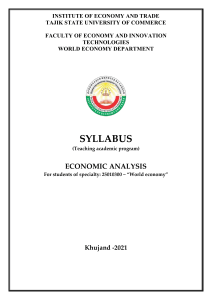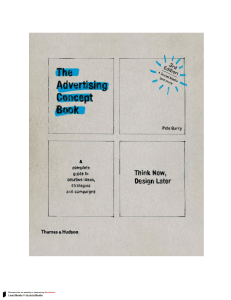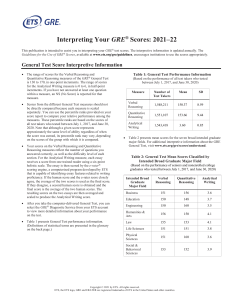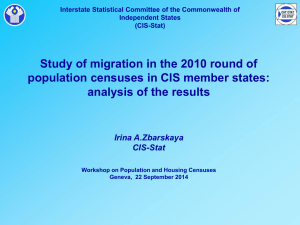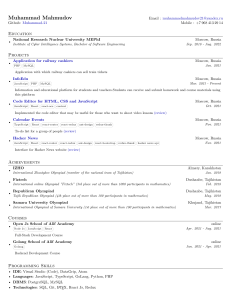
INSTITUTE OF ECONOMY AND TRADE TAJIK STATE UNIVERSITY OF COMMERCE “Approved” Deputy Director of the IET TSUC on Academic affairs docent A.A. Qayumov __________________________ «____» ______________2020 FACULTY: ECONOMY AND INNOVATIVE TECHNOLOGIES DEPARTMENT: WORLD ECONOMY SYLLABUS (Teaching academic program) on course «Economy and International Business organization » For the study programme of 25010300 - «World economy» Form of education: full-time Year of study: 4 Semesters: 7 Number of credits: 6 Lectures: 24 hours Practice: 24 hours Individual work of the student with the instructor (IWSWI): 32 hours Total contact hour classes: 80 hours Individual work of the student: 64 non-contact hours Number of midterm controls: 2 Final examination: 1 Khujand - 2020 2 3 The Syllabus is developed based on the state standard of higher professional education and the state educational standard of the “25.01-Economics and Management” field of study, 1-250103 – World Economy study programme by the senior instructor of the World Economy Department Shuhrat Abdumannonovich Qobilov. Senior instructor of World Economy Department ____________ Sh.A. Qobilov (signature) The Syllabus was discussed and approved in the educational and methodological meeting of the Department. «___» ____________ 2020, Minute №___ Chairman of the Educational-methodological Commission ____________ N.R. Abdulo-Zoda (signature) The Syllabus was discussed and approved in the World economy’s department meeting from «___» __________ 2020, Minute №___ Head of the department _______________ Sh.S. Muhitdinova (signature) The Syllabus was approved in the Scientific and Methodological Council’s meeting of the Economy and Innovative Technologies faculty from «___» ____________ 2020, Minute №___ Dean of the faculty ________________ docent N.Y. Yakubova (signature) Head of the Department of Planning and Controlling Academic Process ________________ docent I.I. Salimov (signature) 4 SYLLABUS А Course title: Economy and International Business organization 4th Year of Study Language of instruction: The form of final control: Number of credits English Examination 5 The year and the semester of study: Course Type (underline): Years: 2020-2021 Mandatory Semester: 7 Schedule of classes Day Time Lecture room Form of the classes __ : __ Lecture __ : __ Practice __ : __ Location Building №1 Classrooms 18 and 39 (except laboratory or other special classes) Building №1 Classrooms 18 and 39 (place of laboratory or other special classes will be announced previously) For more information: Address: Khujand, 13/1A/64 Cell: +992 92 922 5555; Email: sh.qobilov@iet.tj IWSI Lecturer: Sh.А. Qobilov B Educational and methodical materials on discipline: 1. Laws and norm - legal acts: 1.1. Law of the Republic of Tajikistan «About foreign economic activities of the Republic of Tajikistan» - № 869 from December 27 1993 (www.mmk.tj). 1.2. Law of the Republic of Tajikistan "About the investments" - №260 from May 12 2007 (www.mmk.tj). 1.3. Address by Founder of the Peace and Unity National, Leader of Nation H.E. Emomali Rahmon, the President of the Republic of Tajikistan to Majlisi Oli of the RT from December 26, of 2019 (http://www.president.tj/) 2. Basic literature: 2.1. International Business: A Managerial Perspective/Author: Ricky W. Griffin, Mike W. Pustay Edition: 8th edition. Published by Prentice Hall, Inc. Upper Sadie River, New Jersey, 2013 2.2. International Business: Competing in the global marketplace/ Charles W.L. Hill. – 9th ed. Published by McGrawHill Companies, Inc. New-York, 2013. 2.3. Мировая экономика и международный бизнес: учебник / кол. авторов; под общ. ред. д-ра экон. наук, проф. В.В. Полякова и д-ра экон. наук, проф. Р.К. Щенина. — 5-е изд., стер. — М.: КНОРУС, 2008. 2.4. Международные экономические отношения. Международный бизнес: учебник. Под общей редакцией д. э. н. А.Ю. Архипова, к. э. н. Е.П. Пузаковой. – Ростов н/д: Феникс, 2009. 2.5. Тимонина И.Л., Колесникова И.В., Мартиросян Э.Г. Развитие международного бизнеса. – М.: Издательство «Дело» АНХ, 2010. 3. Additional literature: 3.1. Саидмуродов Л.Ҳ. ва дигарон. Бизнеси байналхалқӣ: назария, амалия ва одоб. Китоби дарсӣ – Душанбе: Ирфон, 2002. 3.2. Джон Д. Даниэлс, Ли Х.Радеба. Международный бизнес. – Пер. с англ. М.: Дело Лтд, 1994. 3.3. Филиппова И.А. Организация международной торговли: Учебное пособие. – Ульяновск: УлГТУ, 2002. 3.4. Трухачев В.И., Лякишева И.Н. Ерохин В.Л. Международная торговля: Учебное пособие.- 2-изд., перераб. и доп.-М.: Финансы и статистика; Ставрополь: АГРУС, 2006. 3.5. Шагурин С.В., Шимко П.Д. Экономика транснационального предприятия. - Санкт-Петербург 2008. 3.6. Small Business Management: Entrepreneurship and Beyond, Fifth Edition Timothy S. Hatten, Mesa State College in Grand Junction, Colorado - 2009 5 C The brief content of course 1. Title Economy and International business organization 2. Modules 3. Purpose The course consists of 2 modules (one module per midterm) The subject of Economy and International business organization is the basic discipline for educating specialists 25010300 «World Economy» and designed to prepare professionals - experts in the field of international business activity, give them an understanding of the basic issues of organization of international business and patterns and trends in world markets. 4. Preliminary requirements 5. The course bases on knowledge of the following prerequisites: World economy, International Economics, Basis of business, Economy of the enterprise. Classes organized according to academic hours. During lectures, students will participate in lectures and write lectures’ brief abstract. Knowledge of students will be fastened by a solution of tests and discussion Methods of questions on practice. training IWSI includes a discussion of cases on related topics. IWS assumes individual Study of specified themes, the performance of scientific works, and preparation for classes, midterm and final examinations by students. The training factors After Studying a course, the students will: ✓ Know the conceptual apparatus of discipline and each category characterizing the international business, the main indicators that express condition and dynamics of international business, and especially the organization of the international business. ✓ Be able to conduct international business negotiations, to evaluate the effect of various parameters of world markets to international business, business analysis - indicators in the business decision-making, and choose a way to justify expediency of entering foreign markets. ✓ Be master of solving the problem of insurance, logistics and transportation support business operations, financial management, human resources and other assets on a global level. 6. 1. 2. 3. 4. 5. 6. 7. For effective training, the students must observe "Rules of participation of the student in classes": Do not be late or miss classes without a valid reason Missed classes should be promptly worked out (within 2 weeks after an absence in classes). To have all educational accessories to participate in classes. To be active at the performance of the home tasks. Do not use a mobile telephone and other accessories. To come to classes in the appropriate clothes. To be polite, disciplined to respect itself and environmental. Attention: In the case of violation of above-mentioned rules, students will be disqualified from the lesson D Distribution of credits and course organization D.1 Distribution of credits per semester Semester Credits 7 6 (80 contact hours) Lecture (L) Practice (P) 24 24 IWSI IWS Midterm control Final examination 32 64 2 1 6 P IWSI IWS TOPICS Including L № Total hours D.2 Thematic plan of discipline 1 The main factors of International Business development 9 2 1 2 4 2 Global marketplaces and business centers 9 1 2 2 4 3 Legal, technological and political aspects of the IB 9 2 1 2 4 4 The role of culture in International Business 9 1 2 2 4 5 The theories of international business 9 2 1 2 4 6 Institutions for regulation of the IB 9 1 2 2 4 7 International Strategic Alliances 9 2 1 2 4 8 International Strategic Management 6 1 2 1 2 1 2 Midterm control № 1 3 Total in 1st part 72 12 12 16 32 9 International Marketing 9 2 1 2 4 10 The analysis and selection of foreign markets’ entry modes 9 1 2 2 4 11 TNCs and Transnational banks (TNB) in IB 9 2 1 2 4 12 Small Businesses in international business 9 1 2 2 4 13 International Operations Management 9 2 1 2 4 14 Financial aspects of the International Business 9 1 2 2 4 15 International Human Resource Management 9 2 1 2 4 16 International Organizational Design and Control 6 1 2 1 2 1 2 Midterm control № 2 3 Total in 2nd part 72 12 12 16 32 144 24 24 32 64 Final examination Total for the course 7 Lecture topic: International Business Environment 3.1. Summary: Legal environment of the IB. Influence of TNCs on host countries. Technological environment. Political environment. Political risk. Practice topic: How to avoid political risk? 3.2. Discussion Questions: How domestic laws impact on IB. Describe the impact of host country’s technological environment on IB. IWSI topic: The case "Indonesia—The Troubled Giant" 3.3. Outline of the class: Checkup the knowledge of students and the performance of tasks. Solution of problems and tests on the topic. Tasks for IWS: 1. Compilation of Glossary on Current Topic. 3.4. 2. Additional Study Business Environment in the RT. 3. Preparation to the Closing case questions. Pages Literature Hours L 27 P 1 2.5 27 IWSI 2 2.1 68 IWS 4 2.5 27 L 1 2.1 72 P Total hours 9 2 2.1 72 IWSI Practice topic: Discussion: The best way to help countries. Discussion Questions: How does impact on International Business increased the 2.2. role of the EU & NAFTA? Does the "keiretsu" system prevent to entry the Japanese market? IWSI topic: The case “It’s Time to Cry for Argentina” 2.3. Outline of the class: Checkup the knowledge of students and the performance of tasks. Solution of problems and tests on the topic. Tasks for IWS: 1. Compilation of Glossary on Current Topic. 2.4. 2. Additional Study Marketplace of Central Asia. 3. Preparation to the Closing case questions 3. Topic: Legal, technological and political aspects of the IB 2.5 2 2.1 114 IWS Lecture topic: Features of various marketplaces 2.1. Summary: Evaluate the impact of the political and economic characteristics of the world’s various marketplaces on business. 2 4 2.1 72 Total hours 9 L Lecture topic: The nature and features of the IB Strategic imperatives and factors of International Business development. IB and globalization drivers. Globalization of Markets. Practice topic: Discussion on "Globalization: the pros and cons for IB" 1.2. Discussion Questions: What is the links globalization and IB? Reasons for business internationalization. How International Business differs from domestic? IWSI topic: The case “Economic boom in Bangalore” 1.3. Outline of the class: Checkup the knowledge of students and the performance of tasks. Solution of problems and tests on the topic. Tasks for IWS: 1. Compilation of Glossary on Current Topic. 1.4. 2. Additional Study Globalization and IB. 3. Preparation to the Closing case questions. 2. Topic: Global marketplaces and business centres 1.1. Summary: Total hours 9 2 2.1 2.4 120, 45. P Topic: The main factors and trends of International Business development 1 2.1 2.4 120, 45. IWSI 1 2 2.2 124 IWS Content of topics № Lessons Е Structure of lessons 4 2.1 2.4 120, 45. 8 Topic: The role of culture in IB Lecture topic: Differences in Culture and its impact on IB Summary: Characteristics and elements of culture. Contextual approach Hall. 4.1. Basic culture clusters. Hofstede’s culture dimensions. International management and cultural differences. Practice topic: Approaches to studying cultural differences. Discussion Questions: Discuss the primary characteristics and elements of 4.2. culture. Give some examples of how they impact on IB. Describe the advantages and disadvantages of various approaches to culture analyses. L 2.1 2.4 161, 54. P 2 2.1 2.4 161, 54. IWSI 2 2.2 219 4 2.1 161, 54. L 2 2.1 3.5 268; 35 P Total hours 9 1 2.1 3.5 268; 35 IWSI of tasks. Solution of problems and tests on the topic. Tasks for IWS: 1. Compilation of Glossary on Current Topic. 4.4. 2. Additional Study Business Culture in Tajikistan. 3. Preparation to the Closing case questions. 5. Topic: Theories of International Business Lecture topic: Motivation for international business activities Summary: International trade and the global economy. Classical trade theory. 5.1. Modern trade theory, based on the characteristics of companies. An international investment and global economy. Theories of international investment. 1 2 2.1 315 IWS IWSI topic: The case: Matsushita and Japan's Changing Culture 4.3. Outline of the class: Checkup the knowledge of students and the performance Total hours 9 IWS 4. 4 2.1 3.5 268; 35 Practice topic: Implementation of business theories in practice Tasks for IWS: 1. Compilation of Glossary on Current Topic. 6.4. 2. Additional Study “Features of fair trade” 3. Preparation to the Closing case questions. L of tasks. Solution of problems and tests on the topic. 1 P IWSI topic: The case “The Politics of Trade in Steel” 6.3. Outline of the class: Checkup the knowledge of students and the performance Total hours 9 2 IWSI workers? How classical theories differ from modern? IWSI topic: The case “Home Field Disadvantage” Outline of the class: Checkup the knowledge of students and the performance 5.3. of tasks. Solution of problems and tests on the topic. Explain the different theories of foreign direct investment. What does a special theory of Dunning mean? Tasks for IWS: 1. Compilation of Glossary on Current Topic. 5.4. 2. Additional Study “How to improve investment climate?” 3. Preparation to the Closing case questions. 6. Topic: Institutions for the regulation of the IB Lecture topic: State regulation of the IB activity Summary: The reasons for state intervention in IT. Barriers to international trade. 6.1. Promotion of International Trade. Motives and tools for state regulation of international investment. Major that countries use to restrict investment. Practice topic: Free trade vs Protectionism policy Discussion Questions: Pros and Cons of free trade. Should consumers worry 6.2. that foreign companies use dumping? Impact of the investment to host and home countries? Should the international companies support the development of regional trading blocs? 2 IWS 5.2. Discussion Questions: What are the impacts of ratification of NAFTA on U.S. 4 2.1 420 2.1 420 2.1 420 9 Topic: International Strategic Alliances Lecture topic: International cooperation of companies. Summary: The advantages of strategic alliances. Types of strategic alliances. The 7.1. organization of the strategic alliances. Difficulties functioning of strategic alliances. Changing business conditions. Practice topic: Benefits and Pitfalls of Strategic Alliances Discussion Questions: What are the relative advantages and disadvantages of 7.2. joint ventures, compared with other types of strategic alliances? What factors could cause of new strategic alliances decrease? L 2 P 1 2 of tasks. Solution of problems and tests on the topic. Tasks for IWS: 1. Compilation of Glossary on Current Topic. 7.4. 2. Additional Study “Find out two examples of Strategic Alliances” 3. Preparation to the Closing case questions and Midterm control #1. 8. Topic: International Strategic Management IWSI Total hours 9 IWS 7. 4 Lecture topic: Challenges of international strategic management Summary: Characterize the international strategic management. Assess the basic 8.1. strategic alternatives available to firms. Distinguish and analyze the components of international strategy. 645; 109. 2.1 2.4 645; 109. 2.1 679 3.5 645; 109. L 1 2.1 539 P 2 2.1 539 IWSI Total hours 9 1 2.1 539 IWS IWSI topic: The case “Slimline: Marching to a Different Drummer” 7.3. Outline of the class: Checkup the knowledge of students and the performance 2.1 2.4 4 2.2 418 Practice topic: Components of international strategy 8.2. Discussion Questions: Describe the international strategic management process. Identify and characterize the levels of international strategies L Total hours 9 2 P IWSI topic: The case “Dove—Building a Global Brand” 9.3. Outline of the class: Checkup the knowledge of students and the performance of tasks. Solution of problems and tests on the topic. Tasks for IWS: 1. Compilation of Glossary on Current Topic. 9.4. 2. Additional Study “Formulate your brand for foreign markets” 3. Preparation to the Closing case questions. 1 1 IWSI Tasks for IWS: 1. Compilation of Glossary on Current Topic. 8.4. 2. Additional Study “Strategy and the firm” 3. Discussion of the Midterm control’s results Midterm control #1 9. Topic: International Marketing Lecture topic: International Marketing Management Summary: International marketing and business - strategy. Aspects and pricing 9.1. solutions. Questions and solutions regarding product promotion: advertising, personal selling, sales promotion, PR and distribution. Practice topic: Using the same brand in different markets Discussion Questions: What are the similarities and differences between 9.2. domestic and international marketing? How do your country factors affect product policy of foreign companies? 2 IWS IWSI topic: The case “New conquistador” 8.3. Outline of the class: Checkup the knowledge of students and the performance of tasks. Solution of problems and tests on the topic. 4 2.1 2.2 798; 270. 2.1 2.2 798; 270. 2.2 798; 270. 10 10. Topic: The analysis and selection of foreign markets’ entry modes L 1 P 2 of tasks. Solution of problems and tests on the topic. Tasks for IWS: 1. Compilation of Glossary on Current Topic. 10.4. 2. Additional Study “Prepare a report on potential markets for Tajik product” 3. Preparation to the Closing case questions. 11. Topic: TNCs and Transnational banks (TNB) in IB IWSI 2 IWS Lecture topic: Assessment of alternative foreign markets Summary: Assessment of costs and revenues of potential foreign markets. 10.1. Potential risks of foreign markets’ entry. Exports of goods and services to foreign markets. International licensing and franchising. Specialized modes of entry. Practice topic: Selection of foreign market for entry. Discussion Questions: What we should consider for the proper information 10.2. about potential markets? What are the advantages and disadvantages of various modes of entry into foreign markets? Total hours 9 4 Lecture topic: TNCs as a main “player” of Global Business Summary: TNC - generators IB. Stages of development and sources of 11.1. advantages of TNCs. The features of TNB. Stages of TNBs’ development. Basic operations of TNBs. Advantages of TNBs’ (compared with local banks) Practice topic: Indicators of TNCs activity 11.2. Discussion Questions: What is TNC? List the source of efficiency of TNCs. What is meant by the TNB? The role TNBs in IB. Lecture topic: Forms and patterns of participation of small business in IB Summary: The location and trend of development of small business in the global 12.1. economy. The impact of new competition in the participation of small and medium enterprises (SMEs) in the world economy. Practice topic: The International “Small” vs “Large” businesses 12.2. Discussion Questions: What is the "flexible product line?" What are the essential features of the "new competition" and its impact on the ISB? IWSI topic: The case “Employees Fight to Save the Farm” 12.3. Outline of the class: Checkup the knowledge of students and the performance of tasks. Solution of problems and tests on the topic. Tasks for IWS: 1. Compilation of Glossary on Current Topic. 12.4. 2. Additional Study “Cases of SB internationalization in the RT” 3. Preparation to the Closing case questions. 2.1 835 2.1 589 L 2 P 1 IWSI 2 IWS Total hours 9 4 2.2 46 2.2 46 3.5 8 Total hours 9 L Tasks for IWS: 1. Compilation of Glossary on Current Topic. 11.4. 2. Additional Study “Types of international corporations” 3. Preparation to the Closing case questions. 12. Topic: Small Business in the modern system of IB 589 1 3.6 239 P of tasks. Solution of problems and tests on the topic. 2.1 2 3.6 239 IWSI IWSI topic: Discussion of “Activity of TNCs in Tajikistan” 11.3. Outline of the class: Checkup the knowledge of students and the performance 589 2 3.6 395 IWS IWSI topic: The case “Pillsbury Presses Flour Power in India” 10.3. Outline of the class: Checkup the knowledge of students and the performance 2.1 4 3.6 239 11 L 2 P Lecture topic: The nature of international operations management 13.1. Summary: IOM: issues & tasks. Production & information management. Performance management & TQM in international companies. Total hours 9 1 IWSI Topic: International Operations Management (IOM) 2 IWS 13. 4 2.1 840 2.1 840 Practice topic: Strategic context of international operations management 13.2. Discussion Questions: Relationship of IOM and international marketing? Why the service sector is more closely linked to the developed countries? Topic: Financial aspects of the International Business Lecture topic: International Financial Management 14.1. Summary: Forms of payment in international trade. Describe the techniques used by firms to manage their working capital. IB and exchange rates Practice topic: Assessment of international investment projects Discussion Questions: What are the advantages and disadvantages of payment 14.2. methods? Why do firms use countertrade? Features evaluation of international investment projects. Assessment of foreign-exchange risks IWSI topic: The case “How a Small Firm Rides Foreign-Exchange Waves” 14.3. Outline of the class: Checkup the knowledge of students and the performance 1 2 2 4 2.1 840 2.1 884 2.1 884 2.1 884 L 2 P 1 IWSI topic: The case “You Americans Work Too Hard” 15.3. Outline of the class: Checkup the knowledge of students and the performance of tasks. Solution of problems and tests on the topic. IWSI Total hours 9 2 Tasks for IWS: 1. Compilation of Glossary on Current Topic. 15.4. 2. Additional Study “Features of international HRM in the RT” 3. Preparation to the Closing case questions and Midterm control #2 IWS of tasks. Solution of problems and tests on the topic. Tasks for IWS: 1. Compilation of Glossary on Current Topic. 14.4. 2. Additional Study “Factors affecting the exchange rate of somoni” 3. Preparation to the Closing case questions. 15. Topic: International Human Resource Management (IHRM) Lecture topic: The nature of international HR management Summary: Issues of recruiting and selection of managers for international 15.1. assignments. Training and development of expatriate managers. Performance appraisal and determine compensation for expatriate managers. Basic HR issues involving nonmanagerial employees. Practice topic: Analyze the features of HRM in international business. Discussion Questions: How international HRM related to other functions such 15.2. as marketing, finance, production management? Why and how the scale of the internationalization of the company influences its HRM? 879 Total hours 9 L 14. P Tasks for IWS: 1. Compilation of Glossary on Current Topic. 13.4. 2. Additional Study “Logistic companies in Tajikistan” 3. Preparation to the Closing case questions. IWSI of tasks. Solution of problems and tests on the topic. IWS IWSI topic: The case “A global market for automotive components” 13.3. Outline of the class: Checkup the knowledge of students and the performance 4 2.1 969 2.1 969 2.1 1008 2.4 120 12 Practice topic: General purpose and levels of control in IB. Questions: Describe how international firms manage control function. Give an example and explain any organization design IWSI topic: Midterm control #2 16.3. Outline of the class: Checkup the knowledge of students and the performance of tasks. Solution of problems and tests on the topic. Tasks for IWS: 1. Compilation of Glossary on Current Topic. 16.4. 2. Additional Study “Levels of control in IB” 3. Discussion of the Midterm control’s results. Midterm control #2 The final examination Total hours for the course (contact hours) L 16.2. Discussion 1 2.1 687 P Lecture topic: The nature of international organization design Summary: Essence of international organization design. Initial impacts of 16.1. International Business activity on organization design. Basic forms of international organization design. Hybrid global designs. Total hours 9 2 2.1 687 IWSI Topic: International Organizational Design and Control 1 2.1 734 IWS 16. 4 2.1 687 1 144 (80) F The order of evaluation of students' knowledge The lecturer will determine the actual knowledge of students based on objective assessment. Therefore, the midterm and Final exams always are open and it should be noted that not only other professors and instructors of the department can observe examination process, as well as other interested persons (parents, employers, etc.), are allowed to participate exams. The Final exam will be organized by the Testing center of the Institute (without participation of instructor of the course) in the presence of a commission appointed by faculty administration. These methods of organizing of Final exam provide transparency and impartiality of the assessment of the students’ knowledge. Student can appeal results of the exam to the examination Commission according to Provisions of the IET TSUC “On the procedure for the organization of Final exams”. Forms and time of exams organization and scores distribution Form of control Midterm #1 Midterm #2 Final exam Time of control Scores for the distribution Up to 100 scores (75 scores for the results of testing and other 25 as reward scores) Up to 100 scores (75 scores for the results of 16th week testing and other 25 as reward scores) th 17-19 weeks Up to 100 scores (results of testing) Total for the semester: 8th week % 25 25 50 100 Reward scores distribution for each lesson During the study students can get up to 25 reward scores per one Midterm period (8 weeks) and these scores will be added to the result of midterm exams. 25 reward scores per one Midterm period distributed as follows: 5 of the 25 reward scores are for the active attendance on classes: During a week there are 3 hours of Lecture/Practice classes and 3*8=24 hours in one Midterm period. Students can be rewarded 5/24=0.208 score per each attendance and 3*0.208=0.625 score per week. 13 10 of the 25 reward scores are for the timely performance of IWS tasks: During a week there are 3 tasks for IWS and 3*8=24 tasks in one Midterm period. Students can be rewarded 10/24=0.416 score per each completed task and 0.416*3=1.25 score per week. 10 of the 25 reward scores are for the diligence performance of students on Lecture/Practice classes: During a Midterm period, there are 24 hours of Lecture/Practice classes and 10*24=0.415 score per one hour. Students can be rewarded 3*0.415=1.25 score for completed tasks per week. Thus, students per week can get 0.625+1.25+1.25=3.125 as a reward score and 3.125*8=25 score one Midterm period. The 1st midterm control will be organized in test and open answer forms, and the 2nd midterm control is a result of coursework defense. Selected course work topics should be reviewed by the Scientific supervisor and approved by the department. For the sample of the course, work topics see Appendix number 1. The final exam will be organized according to approved by the Educational department form. The final estimation is determined under the formula: 𝐆𝐞 = 𝐌𝟏 + 𝐌𝟐 ∗ 𝟎, 𝟓 + 𝐅𝐞 ∗ 𝟎, 𝟓 𝟐 where: M1 and M2 - results of first and second midterm examinations (%); Fe - the result of the final examination (%); Ge - general estimation (%). Parameters of examination estimations: ALPHABETIC ESTIMATION NUMERAL ESTIMATION ESTIMATION IN POINTS А АB+ B BC+ C CD+ D Fx F 4,0 3,67 3,33 3,0 2,67 2,33 2,0 1,67 1,33 1,0 0 0 95≤ A≤100 90≤ A-<95 85≤B+<90 80≤B<85 75≤B-<80 70≤C+<75 65≤C<70 60≤C-<65 55≤D+<60 50≤D<55 45≤Fx<50 0≤ F<45 TRADITIONAL SYSTEM OF ESTIMATIONS EXCELLENT GOOD SATISFACTORY UNSATISFACTORY 14 Appendix № 1. Sample of coursework topics 1. Essence, the formation and development stages of the international business 2. The RT integration with the CIS countries and its impact on business organization 3. Legal environment and its impact on the organization of international business 4. The political environment of international business 5. International leasing as a form of international business 6. Analysis of the structure and dynamics of direct foreign investments 7. Analysis of the structure and dynamics of international portfolio investment 8. Features of the cultural environment of international business 9. The role of the insurance industry in the international business 10. Electronic money, as a factor in improving operations in IB 11. Essence, classification and influence exchange rates on operations IB 12. The forms and methods of the international exchange of intellectual property 13. The role of international banks in the development of international business relations 14. MNCs influence on the economic development of countries - recipients 15. The role of diplomacy in international business 16. Global distribution of sources of supply and production organization 17. Features organizational structure of international firms 18. Factors affecting the improvement of the investment climate in the country 19. Free economic zones as a factor in international business development 20. Features of state intervention in the sphere of international business 21. Advertising and promotion in the international market 22. Issues of the International Operations Management in TNCs 23. Role, significance and types of negotiation in international business 24. Features of the organization of the international e-business in Tajikistan 25. The role of TNCs in the development of international business 26. Management functions in international business 27. Compliance issues of ethics and social responsibility in international business 28. World stock markets: issues and prospects 29. Features of analysis and selection of partner country in international business 30. Problems of selection a foreign partner in international business 31. Assessment and justification of export of domestic products (on the example of specific products) 32. Foreign countries experience of state export promotion (lessons for RT) 33. Export as a way to enter the foreign market (on the example of a specific company) 34. Justification of the commercial benefits of an international investment project (on the example of a specific project) 35. FDI as a way to enter the foreign market (on the example of a company) 36. Justification of the commercial benefits of using a foreign franchise in the RT (on the example of a specific franchise) 37. Franchising as a way to enter the foreign market (on the example of a specific company) 38. Licensing as a way to enter the foreign market (on the example of a specific company) 39. Development and commercial justification of a tourist product (on the example of RT) 40. Development and commercial justification of a tourist route (on the example of RT) 15 16
